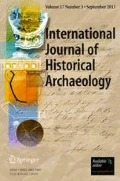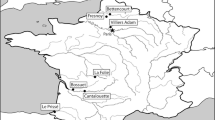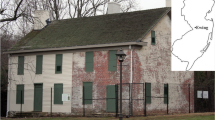Abstract
Photographs and documentary accounts relating to Geronimo’s 1886 attempted surrender at the Cañon de los Embudos site are used to explore the archaeological nature of structure or hut imprints. These primary written and visual sources provide a basis for understanding the extremely unobtrusive nature of these shelter remains. Archaeological footprints from this site today reveal that house construction patterns are consistent with mobile groups in general when under circumstances similar to those at the surrender site.









Similar content being viewed by others
References
Ayer, Mrs. E. E. (trans) (1965). The memorial of Fray Alonso de Benavides. Horn and Wallace, Albuquerque.
Betzinez, J., and Nye, W. S. (1987). I Fought with Geronimo, University of Nebraska Press, Lincoln.
Binford, L. (1990). Mobility, housing, and environment: A comparative study. Journal of Anthropological Research 46: 119–152.
Bourke, J. G. (1980). On the Border with Crook, Charles Scribner’s Sons, New York.
Bourke, J. G. (1891). Arrows and Arrow Makers. Remarks. American Anthropologist 4(1): 71–74.
Diehl, M. W. (1992). Architecture as a material correlate of mobility strategies: Some implications for archeological interpretation. Cross-Cultural Research 26: 1–35.
Donaldson, B. R., and Welch, J. R. (1991). Western Apache dwellings and their archaeological correlates, Mogollon V, Coas Publishing and Research, Las Cruces, pp. 93–105.
Faulk, O. B. (1969). The Geronimo campaign, Oxford University Press, New York.
Flint, R., and Flint, S. C. (2005). Documents of the Coronado Expedition, 1539-1541:“They were not familiar with his Majesty nor did they wish to be his subjects., Southern Methodist University Press, Dallas.
Goodwin, G. (1929-39). Early shelters, fortified camps, and wickiups. Unpublished materials on Western Apache dwellings and Shelters, Ms. 17, Folder 54. Arizona State Museum Archives, Tucson.
Hammond, G. P., and Rey, A. (1966). The rediscovery of New Mexico, 1580-1594, Quivera Society Publications, Los Angeles.
Hayes, A. C. and Hayes, K. (1991). Sierra Madre revisited. Journal of Arizona History Summer: 125-152.
Herskovitz, R. M. (1978). Fort Bowie material culture, University of Arizona Press, Tucson.
Hunter-Anderson, R. L. (1977). A theoretical approach to the study of house form. In Binford, L. R. (ed.), For theory building in archaeology: Essays on faunal remains, aquatic resources, spatial analysis, and systemic modeling, Academic, New York, pp. 287–315.
McGuire, R. H., and Schiffer, M. B. (1983). A theory of architectural design. Journal of Anthropological Archaeology 2: 277–303.
O’Connell, J. F. (1987). Alyawara site structure and its archaeological implications. American Antiquity 52: 74–108.
Pilles Jr., P. J. (1981). A review of Yavapai archaeology. In Wilcox, D. R., and Masse, W. B. (eds.), The protohistoric oeriod in the American Southwest. A.D. 1450-1700, Arizona State University Anthropological Research Papers 24, Arizona State University, Tempe, pp. 163–182.
Polzer, C. W., and Burrus, E. J. (1971). Kino’s biography of Francisco Javier Saeta, S.J. Jesuit Historical Institute, St. Louis University, St. Louis.
Robbins, M. C. (1966). House types and settlement patterns: An application of ethnology to archaeological interpretation. Minnesota Archaeologist 28: 3–26.
Rogers, M. J. (1939). Early lithic industries of the lower basin of the Colorado River and adjacent desert areas, San Diego Museum, San Diego.
Rogers, M. J. (1966). Ancient hunters of the far West, Union-Tribune Publishing, San Diego.
Sahlins, M. (1972). Stone age economics, Aldine-Atherton, Chicago.
Seymour, D. J. (1990). A methodological perspective on the use and organization of space: A case study of Hohokam structures from Snaketown, Arizona, Doctoral dissertation, University of Arizona, Tucson.
Seymour, D. J. (2002). Conquest and concealment: After the El Paso Phase on Fort Bliss, Report prepared for Conservation Division Directorate of Environment, Fort Bliss.
Seymour, D. J. (2004). A ranchería in the Gran Apachería: Evidence of intercultural interaction at the Cerro Rojo site. Plains Anthropologist 49: 153–192.
Seymour, D. J. (2008). Surfing behind the wave: A counterpoint discussion relating to “A Ranchería in the Gran Apachería. Plains Anthropologist 53: 241–262.
Seymour, D. J. (2009a). Distinctive places, suitable spaces: Conceptualizing mobile group occupational duration. International Journal of Historical Archaeology 13(3): 255–281.
Seymour, D. J. (2009b). Nineteenth-century Apache wickiups: Historically documented models for archaeological signatures of the dwellings of mobile people. Antiquity 83: 157–164.
Seymour, D. J. (2010a). Cycles of renewal, transportable assets: Aspects of ancestral Apache housing. Plains Anthropologist 55: 133–152.
Seymour, D. J. (2010b). Contextual incongruities, statistical outliers, and anomalies: Targeting inconspicuous occupational events. American Antiquity 75: 158–176.
Seymour, D. J. (2012). When data speak back: Resolving source conflict in Apache residential and fire-making behavior. International Journal of Historical Archaeology,forthcoming.
Seymour, D. J., and Robertson, G. (2008). A pledge of peace: Evidence of the Cochise-Howard Treaty campsite. Historical Archaeology 42(4): 154–179.
Smith, C. S. (2003). Hunter-gatherer mobility, storage, and houses in a marginal environment: An example from the mid-Holocene of Wyoming. Journal of Anthropological Archaeology 22: 162–189.
Treutlein, T. E. 1949. Missionary in Sonora: The travel reports of Joseph Och, S.J., 1755-1767. California Historical Society, San Francisco.
Van Orden, J. (1991). Geronimo’s surrender: The 1886 C.S. Fly photographs. Arizona Historical Society, Tucson.
Upham, S. (1994). Nomads of the desert West: A shifting continuum in prehistory. Journal of World Prehistory 8: 113–167.
Whiting, J. W., and Ayers, B. (1968). Inferences from the shape of dwellings. In Chang, K. C. (ed.), Settlement Archaeology, National Press, Palo Alto, pp. 117–133.
Author information
Authors and Affiliations
Corresponding author
Rights and permissions
About this article
Cite this article
Seymour, D.J. Geronimo’s Wickiup: Methological Considerations Regarding Mobile Group Hut Signatures. Int J Histor Archaeol 17, 182–195 (2013). https://doi.org/10.1007/s10761-012-0215-9
Published:
Issue Date:
DOI: https://doi.org/10.1007/s10761-012-0215-9




